Business Etiquette Training Course in Singapore
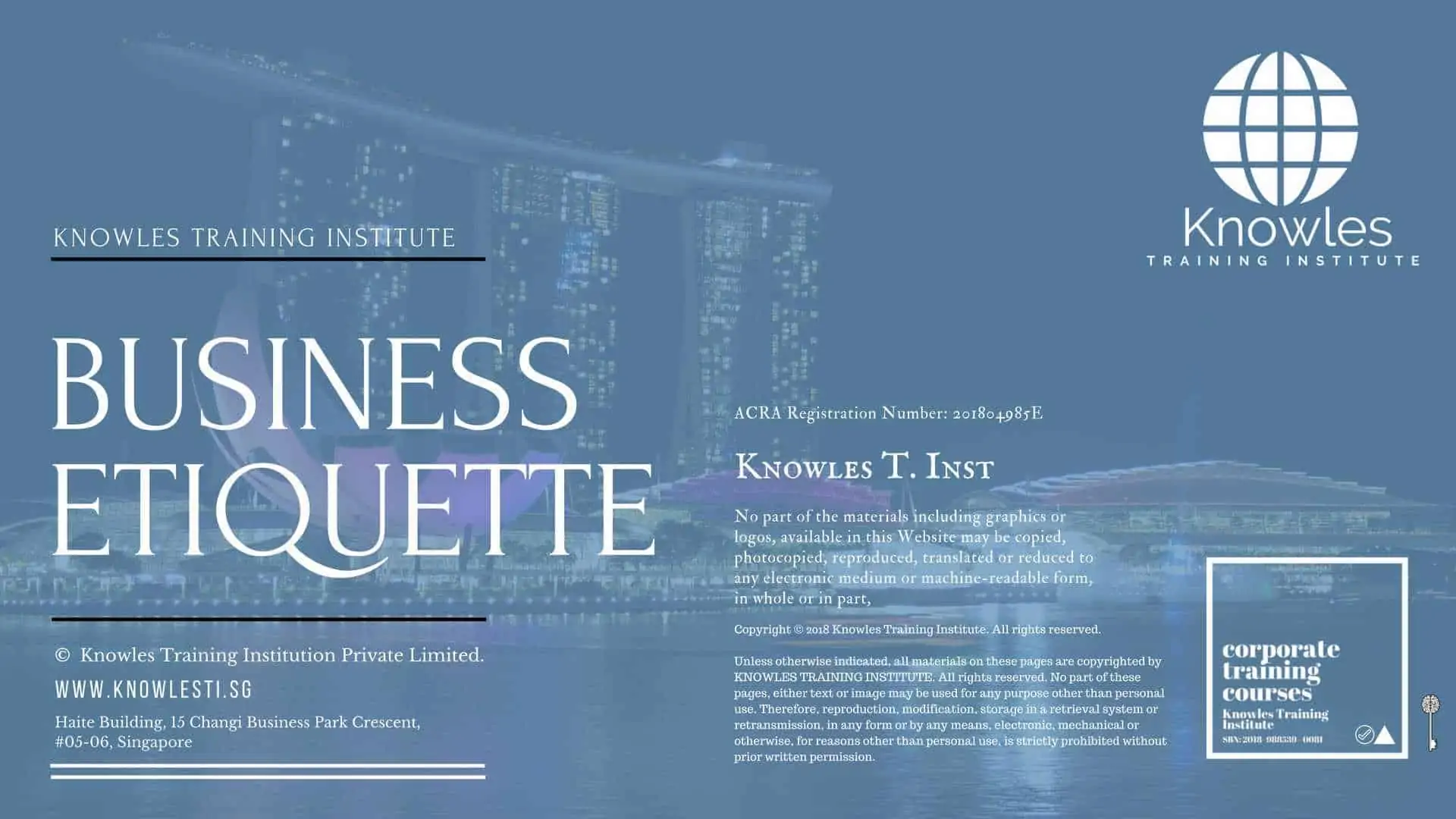
About This Business Etiquette Training Course
About this Business Etiquette Course in Singapore
Business Etiquette is the set of expected behaviour exhibited by business professionals to build an essential first impression. In order to build strong relationships with other people, knowledge of the proper decorum during social interactions is necessary. Business opportunities are often decided in a matter of minutes, and having less capacity to impress clients lessens the chance of acquiring the deal.
Knowing Business Etiquette helps professionals prepare themselves for handling business deals and creating professional relationships with potential clients. More so, participants will learn the importance of understanding the diversity of culture in creating secure networks.
In this Business Ethics course, participants will learn the basic rules of business etiquette. They will be guided on the basic principles to follow in showing politeness and respect towards clients. The course will handle business etiquette in terms of verbal, nonverbal, and written communication. Also, participants will be briefed on the cultural differences which they need to note.
Who Should Attend This Business Etiquette Workshop
This Business Etiquette workshop is ideal for anyone who would like to gain a strong grasp and improve their time management.
All Staff Within An Organisation
Managers
Team Leaders
Executives
Assistants
Officers
Secretaries
Group Size For This Business Etiquette Training Program
The ideal group size for this Business Etiquette course is:
Minimum: 5 Participants
Maximum: 15 Participants
Course Duration For This Business Etiquette Skills Course
The duration of this Business Etiquette workshop is 2 full days. Knowles Training Institute will also be able to contextualised this workshop according to different durations; 3 full days, 1 day, half day, 90 minutes and 60 minutes.
2 Full Days
9 a.m to 5 p.m
Business Etiquette Course Benefits
Below Is The List Of Course Benefits Of Our Business Etiquette Course
- Develop Professionalism Through The Knowledge Of Business Etiquette
- Discover How To Deal With Various Kinds Of Clients
- Understand The Cultural Differences In Handling Deals Among Different Nationalities
- Improve Existing Practices In Dealing With Clients
- Obtain Skills Needed For Establishing A Good Impression To Clients
Business Etiquette Course Objectives
Below Is The List Of Course Objectives Of Our Business Etiquette Course
Business Etiquette Training Objectives – Part 1
- Define etiquette and give an example of how etiquette can add value to a business or company.
- Learn guidelines on how to make a great first introduction.
- Learn the three components of a good impression, all starting with ‘C’.
Business Etiquette Training Objectives – Part 2
- Know at least one way to reduce nervousness while in group situations.
- Learn how to use a business card effectively.
- Know and put into practice at least one way to remember names.
Business Etiquette Training Objectives – Part 3
- Identify three steps in giving a handshake.
- Identify the four levels of conversation and present an example for each.
- Learn place settings, napkin etiquette, and basic table manners.
Business Etiquette Training Objectives – Part 4
- Learn the protocol in ordering in an establishment, handling alcohol in a business meal, paying the bill, and tipping.
- Learn basic guidelines about a proper form of address, grammar standards, and use of acronyms in e-mails.
- Learn basic guidelines about the phone-calls and voice-mail.
Business Etiquette Training Objectives – Part 5
- Identify the difference between a formal and informal letter.
- Develop an effective ‘Thank You’ note.
- Learn the meaning of colors in dressing for success.
Business Etiquette Training Objectives – Part 6
- Distinguish between the dressy casual, semi-formal, formal and black tie dress code.
- Understand basic guidelines in international etiquette.
Course Content For This Business Etiquette Training Course
Below Is The List Of Course Content Of Our Business Etiquette Training Course
Business Etiquette Course – Part 1
Before we look at etiquette rules across multiple business-related scenarios, it is best to teach everyone what etiquette means. We would also look at the many ways business etiquette can improve a company or an organisation’s bottom line.
- Etiquette Defined
- Josy Roberts, writer of ‘Business Etiquette Your Questions and Answers’, defines etiquette as ‘conventional rules of polite behaviour.’ They are guidelines on how to perform befitting good manners while in the company of other people. They show sympathy for the needs and feelings of the person.
- The Importance of Business Etiquette
- Etiquette can help businesses promote the following areas:
- Branding: Everything we do will reflect on our company and our products.
- Customer Care: The best way to show customers that their patronage is valued is to handle them with respect and consideration.
Business Etiquette Course – Part 2
When networking, it is essential to make the most of the first meeting. In this module, we discuss how to create a compelling introduction, make a good impression, reduce nervousness, use business cards effectively, and remember names.
- Creating an Effective Introduction
- There are three steps to introducing effectively. Networking is not just presenting oneself but also to introduce two strangers to one another.
- Making a Great First Impression
- Having a great impression requires 3 C’s: Confidence, Competence, Credibility.
- Minimising Nervousness
- Meeting people can be anxiety-provoking. The need to impress another person can be much pressure. Here are some ways to minimise nervousness while in a social situation: Be informed, always practice and learn to identify triggers.
- Using Business Cards Effectively
- Networking is not comprehensive without exchanging business cards. The business card is very vital to follow up to arrange the next meeting.
- Remembering Names
- Remembering names may be challenging for some people, but it is not impossible. It is a skill which improves with diligent application.
Business Etiquette Course – Part 3
A handshake and conversation almost always accompany an introduction. In this module, we would discuss the three steps that make a perfect handshake and the four levels of conversation.
- The Three-Step Process
- A handshake is a component of many social interactions. It is a method to introduce one’s self, offer congratulations and even a way to conclude a business deal. A handshake is a display of goodwill.
- The Four Levels of Conversation
- The real technique of conversation is not only to say the right information at the right time but to omit the wrong thing at a tempting moment. It entails sensitivity at this stage of a relationship, the context of the dialogue and the comfort level of the person you are communicating to depend on it.
Business Etiquette Course – Part 4
Conducting business over meals is a great way to build business relationships. Meals make for a more casual atmosphere compared to offices and are therefore more conducive for a relaxed discussion. In this module, we would discuss some of the etiquette rules when dining with business associates such as understanding place setting, etiquette rules while eating, and ways to avoid sticky situations.
- Understanding Your Place Setting
- A place setting is an arrangement of the drinking vessels (glasses, mugs), food receptacles (plates, bowls, and saucers), and utensils (spoons, forks, knives).
- Place settings differ depending on the food and the formality of the dining event. The more informal you intend your meal to be, the less rigidly you have to adhere to the rules of a place setting.
- Using Your Napkin
- When everyone is seated, lightly unfold your napkin and place it on your lap. If the napkin is big, fold the napkin in half first. Your napkin resides on your lap during the entire meal. If you need to use your napkin to wipe something on your lips, just dab it lightly.
- Eating Your Meal
- Basic etiquette guidelines when dining: Don’t discuss business during the meal proper, unless the senior members want to do so. Otherwise, business matters should be approached either before the meal or after it. Take the lead from the host, or the most senior in the table, where to sit.
- Sticky Situations and Possible Solutions
- Here are some uncomfortable dining circumstances and how to deal with them. Consuming something that doesn’t agree with you, ask the waiter for a paper napkin and discreetly spit the food out. You unintentionally spilt food or drinks on a guest: Don’t panic. Apologise sincerely first. Use the cloth napkin and water to wipe the spill gently.
Business Etiquette Course – Part 5
In the previous module, we talked about etiquette guidelines relating to dining in style. In this module, we will look at basic courtesies to observe while eating out, including guidelines in ordering in a restaurant, intake of alcohol during a business meeting, paying the bill and tipping.
- Ordering in a Restaurant
- The following are some basic etiquette rules when ordering: As with numerous places, say ‘please’ and ‘thank you’ especially when addressing the waiter or server. Don’t order the most expensive item. When in uncertainty, follow the lead of the host.
- About Alcoholic Beverages
- In general, alcohol is not advised to be part of a business meeting. Alcohol intake lowers inhibition, which might affect the professional atmosphere at the table. Even if the meal is a social occasion meant to establish a relationship, you’d still want to project your best in front of possible partners and clients.
- Paying the Bill
- Here are some etiquette suggestions when paying the bill: If the slip is brought to your table, pick it up and check the total without remark. Put the check face downon the tray in a folder with your card or money underneath. Don’t fuss with the check. Don’t let the others know how much the meal cost.
- Tipping
- Tip appropriately. The standard is 15% for moderate service and 20% for excellent service of the pre-tax cost of the meal. In a self-service or buffet-style restaurant, a tip of 10-12% is standard. Deal with bad food or service by speaking to the manager.
Business Etiquette Course – Part 6
Email is a convenient and effective medium to conduct business communication. In this module, we will discuss etiquette guidelines on how to address an email message, the use of grammar and acronyms in the letter body and top 5 technology tips.
- Addressing Your Message
- A couple of basic guidelines in addressing an email: Comprehend when to use the To, Cc and Bcc fields. There are three common ways to address an email, and each way is most appropriate to specific contexts.
- Grammar and Acronyms
- While online mediums of expression have developed their vocabulary, it’s best to remember that business emails the equivalent formality as any business letter. Always observe the rules of proper grammar. You may refer to English writing style examples for these rules. Always practice full sentences and words with proper sentence structure.
- Top 5 Technology Tips
- Here are five tips when using technology: the medium is the message, always re-read your letters, think security, think of your recipient’s convenience and skip if it is not necessary. Before you forward a memo you’ve received to your staff, consider if they need this piece of information. It’s nice to keep your team updated, but not to the point that you’re clogging their inboxes.
Business Etiquette Course – Part 7
This time we will look at telephone etiquette. In particular, we will discuss how to develop an appropriate greeting, how to deal with voicemail and cell phone do’s and don’ts.
- Developing an Appropriate Greeting
- How to generate an appropriate phone greeting: Say your greeting. Business telephones should always be answered with a phrase like, “Good morning” or “Good Afternoon.” Identify yourself and the company.
- Dealing with Voicemail
- Some tips on leaving a voicemail message: you can try to state your name, affiliation, phone number and your reason for calling. For managing your voicemail, you should record your personalised greeting. Include in your greeting your name, the department and or company name so that people know they have contacted the correct person.
- Cell Phone Do’s and Don’ts
- Here are some do and don’ts when it comes to mobile phones: Don’t accept calls during a meeting or a conversation with another person. Exclusions are when you receive an urgent call, but excuse yourself first before taking it.
Business Etiquette Course – Part 8
Even in written communication, appropriate tone, content and format must be observed. In this module, we would discuss how to write a ‘Thank You’ note, a formal letter and an informal letter.
- Thank You Notes
- Showing appreciation is always a good idea, whether it’s for a gift, an act of kindness, or a business courtesy. You can do this by sending a ‘thank you’ note. The formality of your thank you note depends on your relationship with the person you’re sending the note to.
- Formal Letters
- A formal style is advised for most business correspondence. It exhibits courtesy, professionalism, and knowledge of protocol. As a rule, use a formal style unless invited otherwise or you have already established a relationship with the person you’re writing to.
- Informal Letters
- An informal business letter is a more precise and more straight-forward version of a formal letter. Standard rules on grammar and spelling correctness still apply, but with certain flexibilities. For example, contractions, abbreviations, and slang may be permissible as long as the professional tone of the letter is preserved.
Business Etiquette Course – Part 9
A significant part of practising etiquette is proper self-presentation. The way you look talks to people, not just how you want to project yourself, but also the courtesy you have for the people in your company. In this module, we will discuss guidelines in dressing for success. In particular, we would talk about the meaning of colours, the meaning of dress codes and guidelines on how to choose the right clothes to wear.
- The Meaning of Colours
- In general, standard colours are perceived as more professional and relevant for business-related situations. These colours include black (which is viewed as the most formal), white, dark-grey, and navy blue. A lot of companies use colour dress code for building their brand as employees interact with the consumers.
- Interpreting Common Dress Codes
- Dress codes usually depend on the company or industry you work in, and the nature of your job. It is also not uncommon for different activities in the same position to call for different dress codes.
- Deciding What to Wear
- When attending a work-related social function, attempt to ascertain how your host or hostess would prefer you to dress and conform with their response. There is nothing wrong in making queries about dress codes beforehand. Casual generally implies that you can wear whatever you want.
Business Etiquette Course – Part 10
Etiquette is heavily influenced by culture; each country and nation has its own set of rules for polite behaviour. When dealing with an international clientele, or when conducting business in a foreign country, it’s best to be aware of local etiquette guidelines. In this module, we would discuss general rules in international etiquette, essential points, and ways to prepare.
- General Rules
- Etiquette is massively influenced by culture; what may be good manners in one country or to one nation may not be good practices in another. As most businesses today are operating with a global mindset, it pays always to keep international etiquette in mind.
- Important Points
- Some cultures dress conservatively as the norm. Americans tend to be more relaxed when it comes to dressing codes and even recommends dressing for comfort in some fields and professions, whereas other people are generally more conservative.
- Preparation Tips
- It starts with being open-minded. You may find informants or experts with skilled local knowledge of both countries, and ask them to talk to you over a nice lunch or dinner. If you reside near a university or a centre of expertise on a particular country, it can also be beneficial to seek guidance from experts who will probably be only too glad to be consulted and share their knowledge.
Business Etiquette Value Added Materials
Each participant will receive the following materials for the time management course
Business Etiquette Learner’s Guide
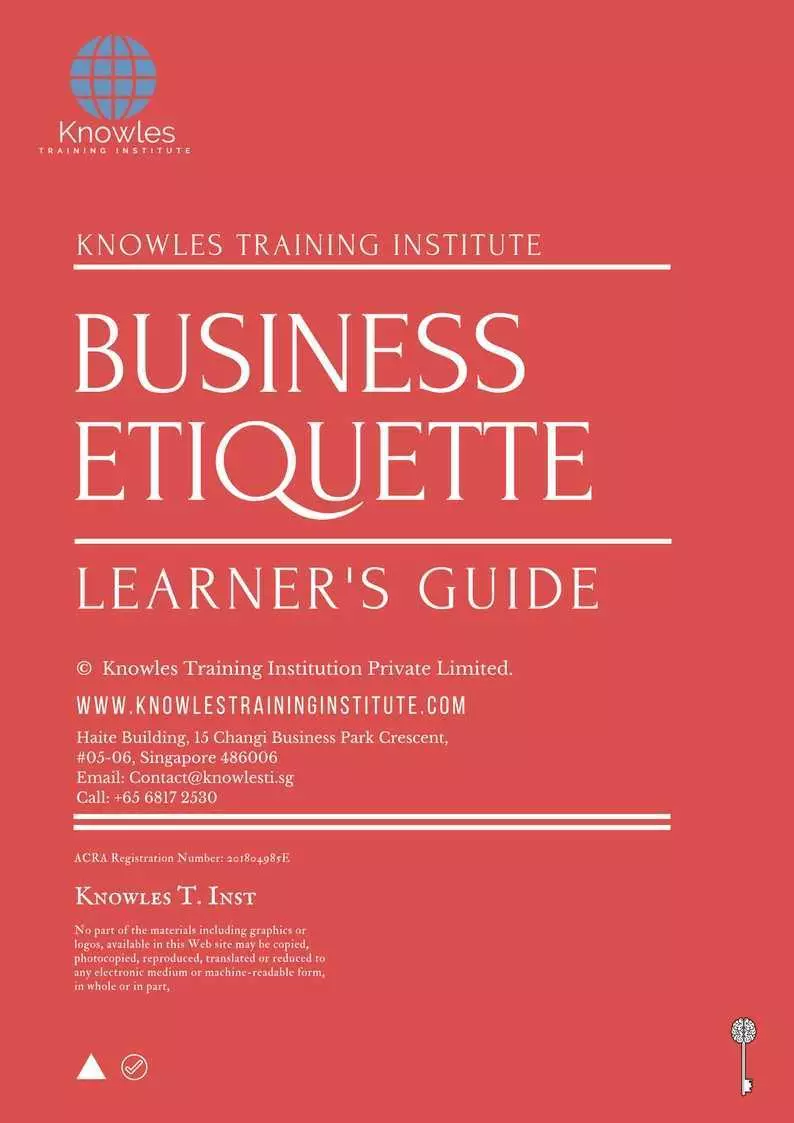
Business Etiquette Key Takeaways Notes
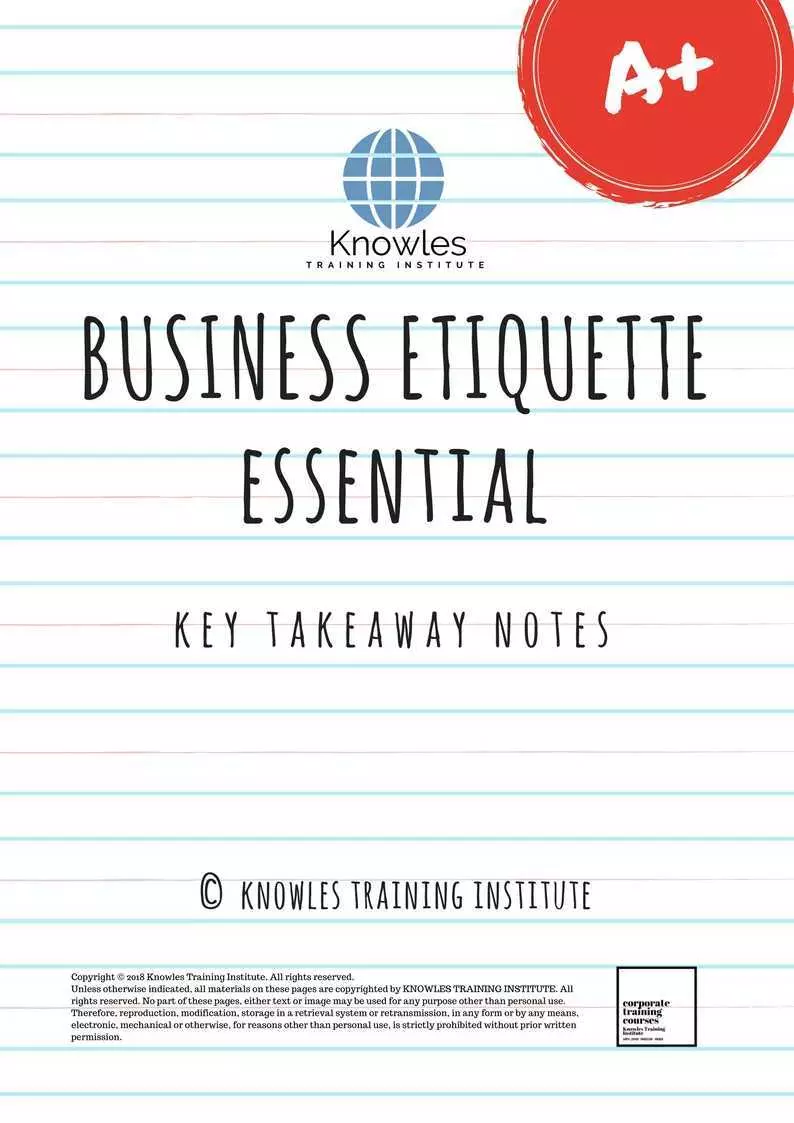
Business Etiquette Essentials Ebook
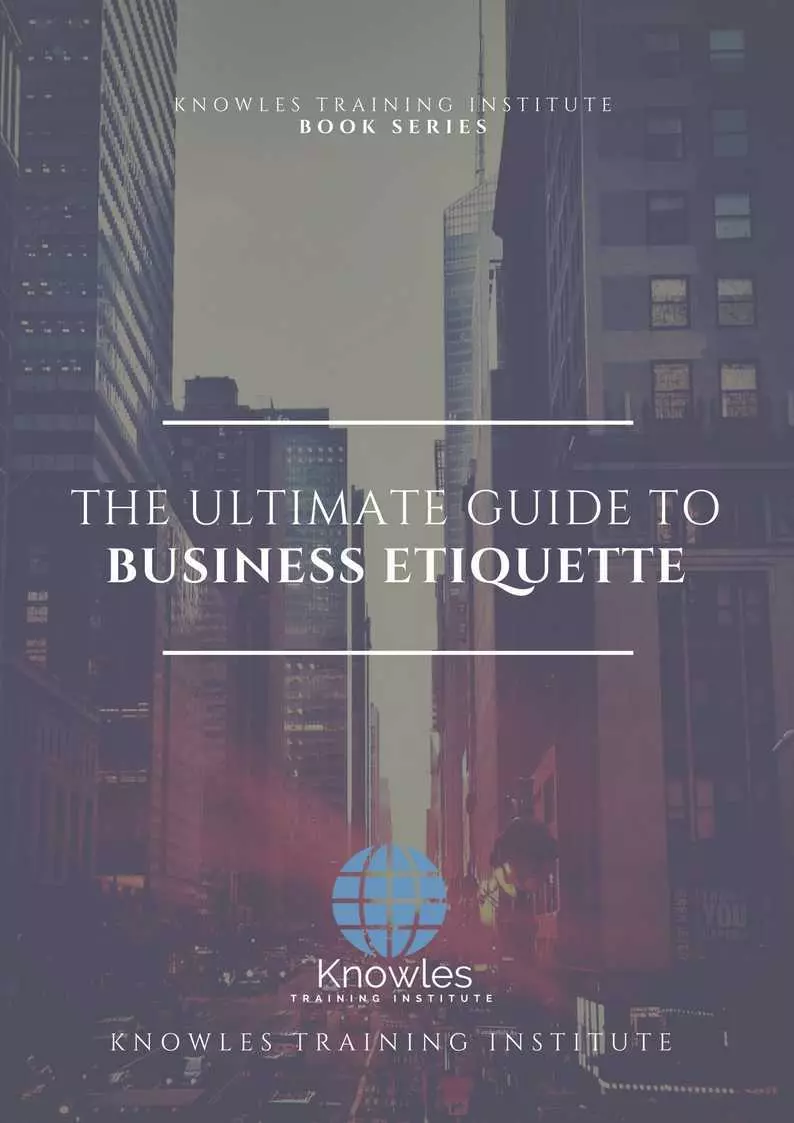
Business Etiquette Course Handouts
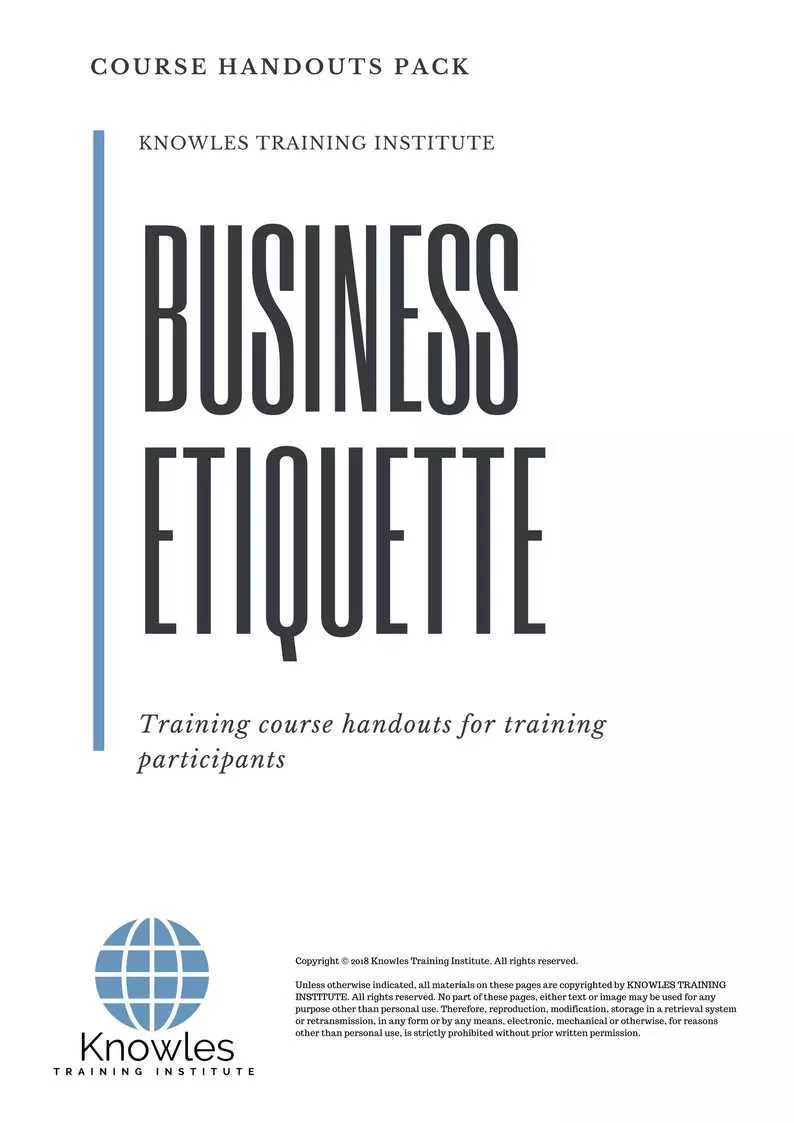
Business Etiquette 30-Day Action Plan
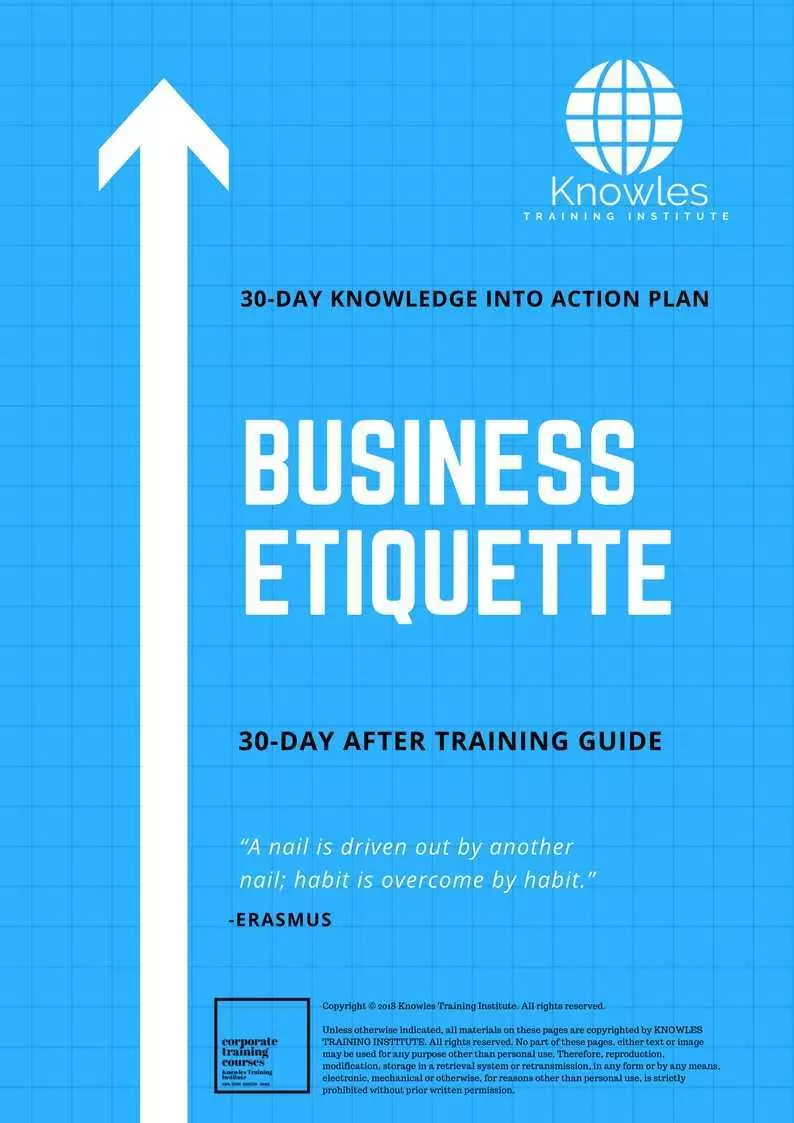
Business Etiquette MindMaps Pack
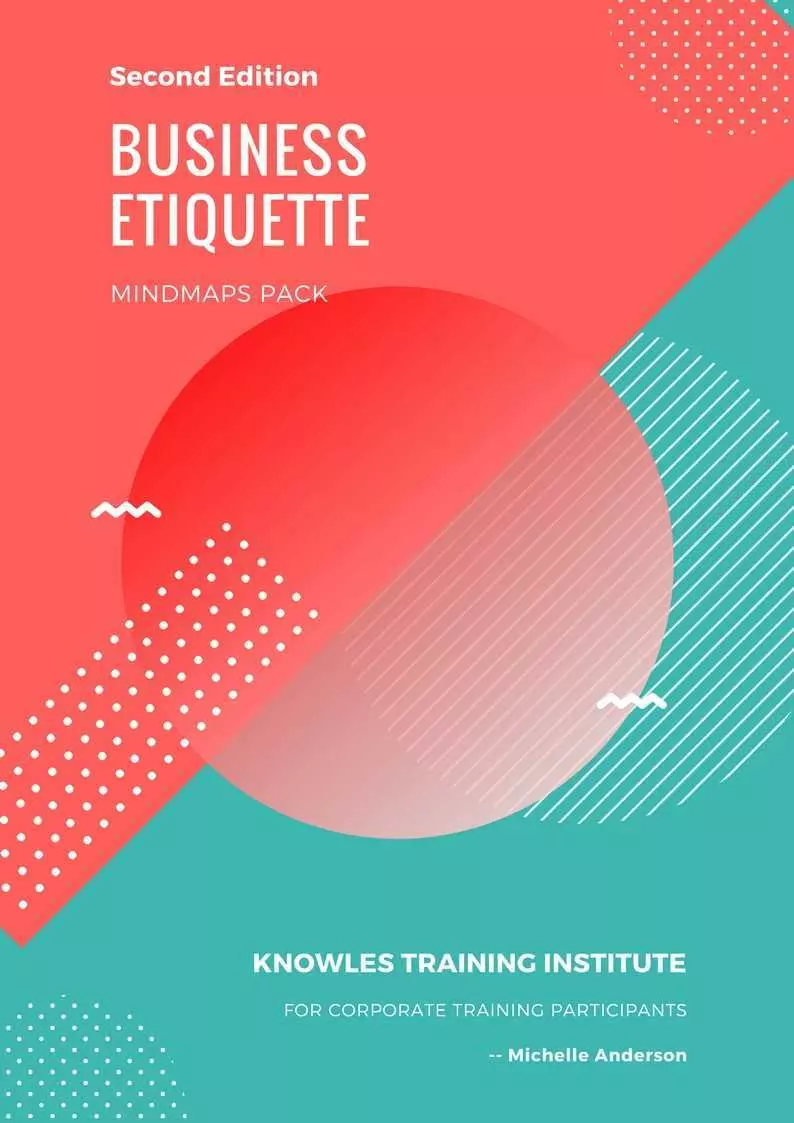
Business Etiquette PPT Slides Used During Course
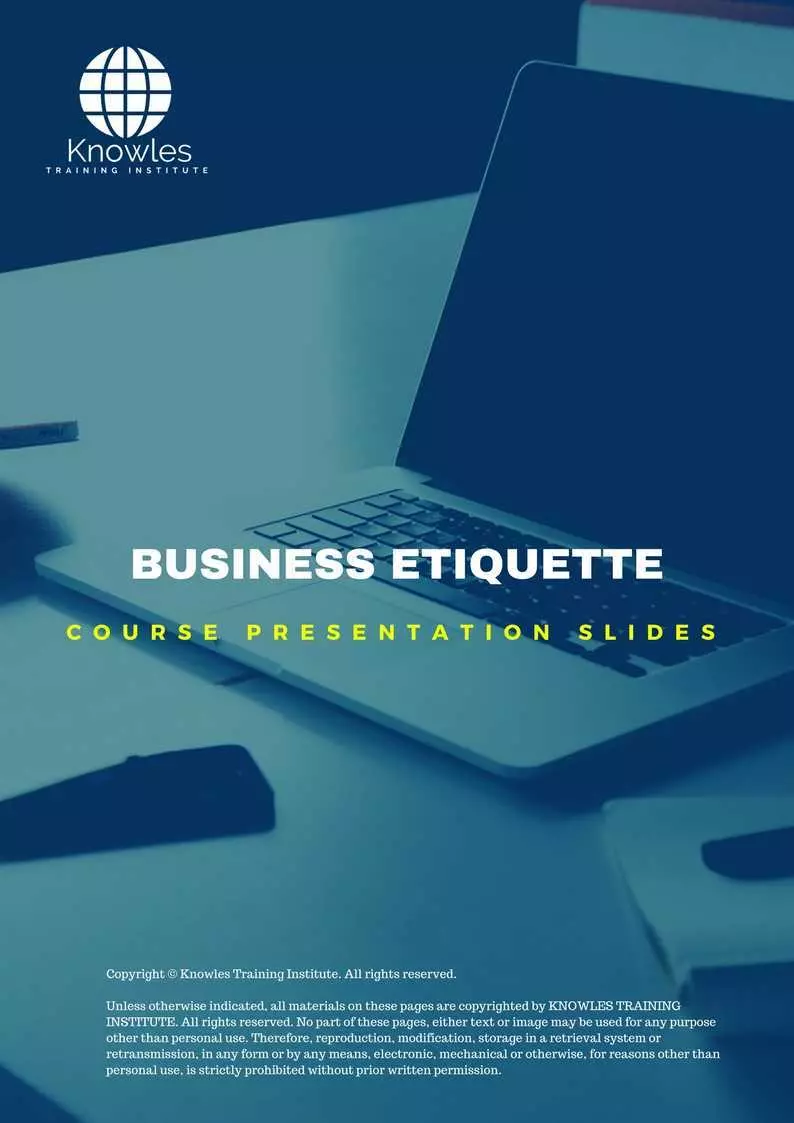
Business Etiquette Long-Term Memory Flashcards Pack
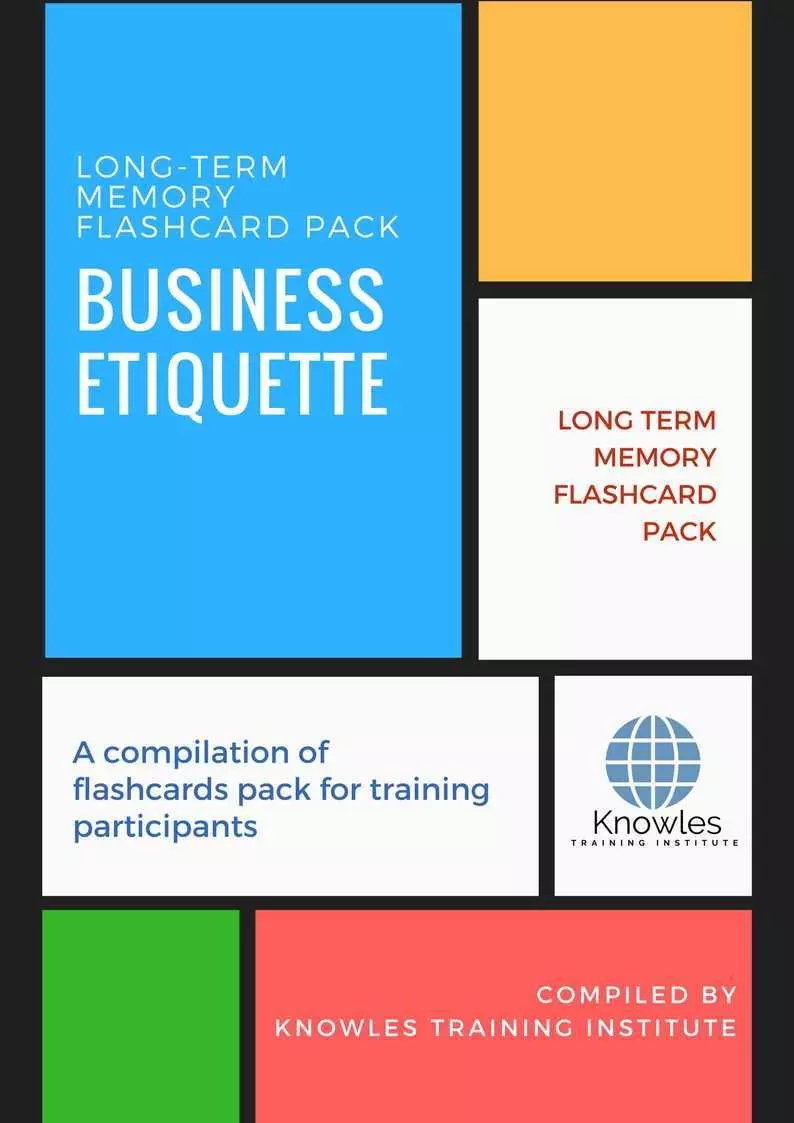
Business Etiquette E-Learning Course

Business Etiquette Online Video Course
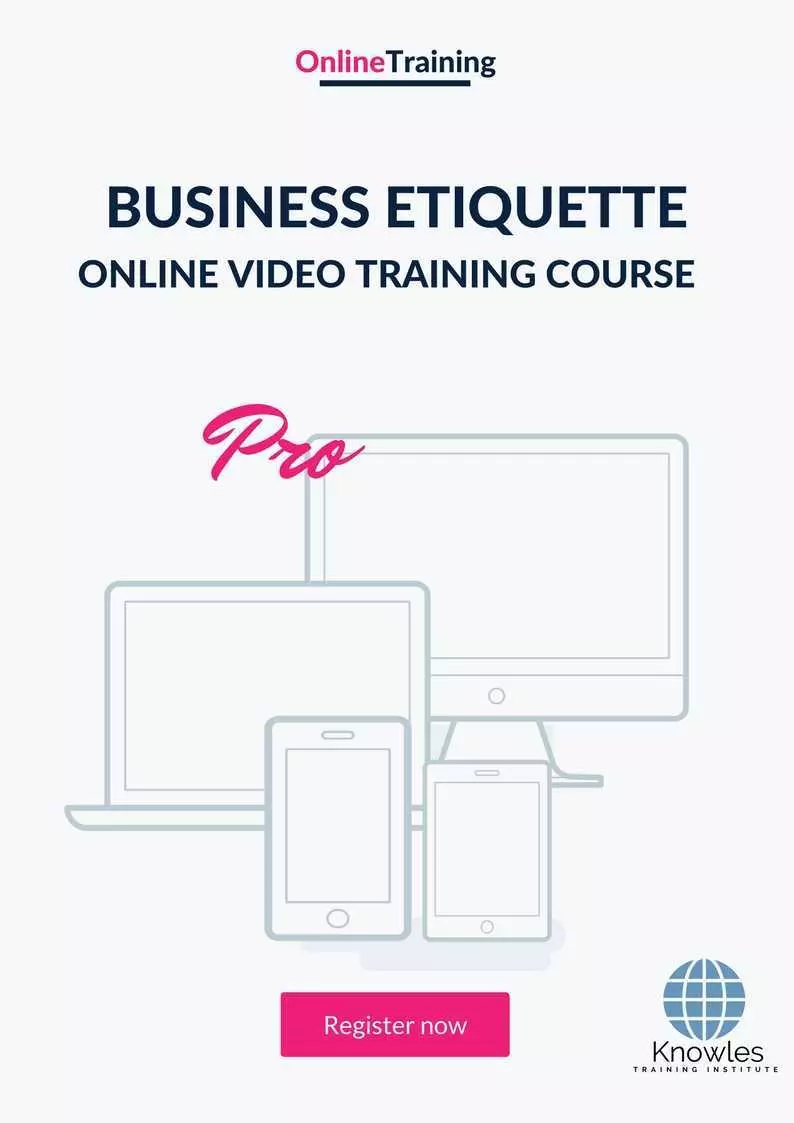
Business Etiquette Essentials Audiobook
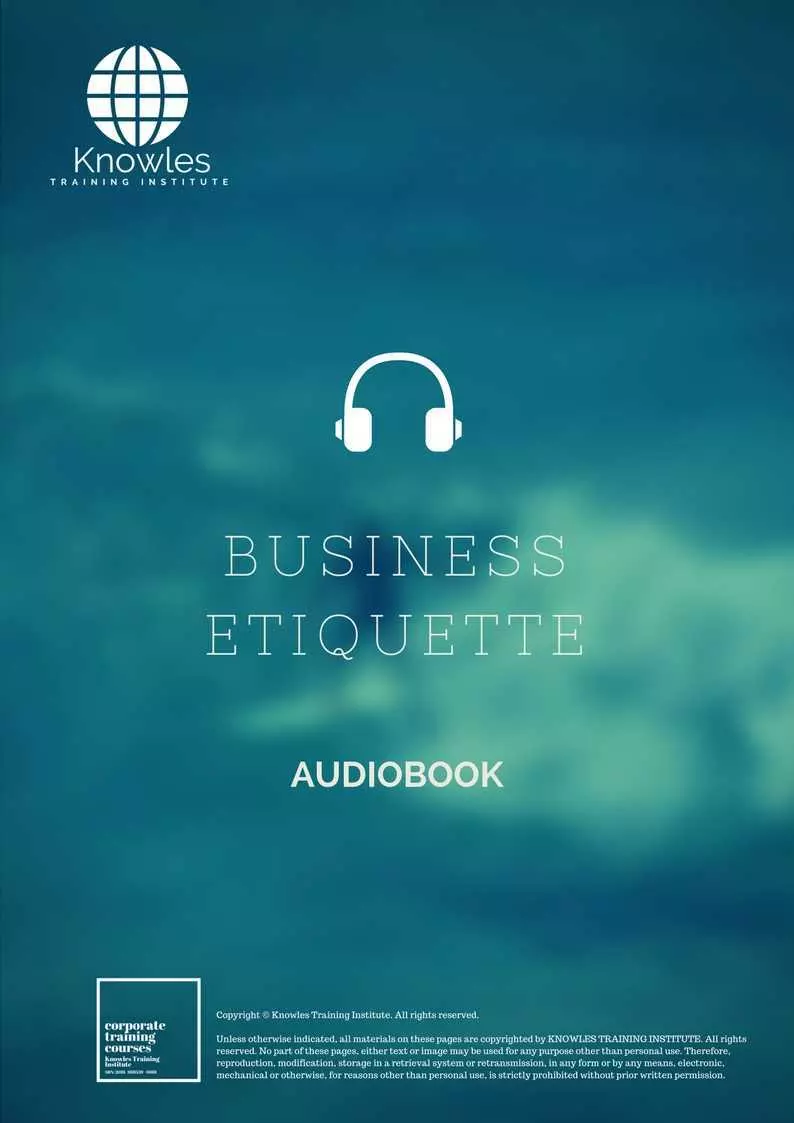
Business Etiquette Infographics Pack
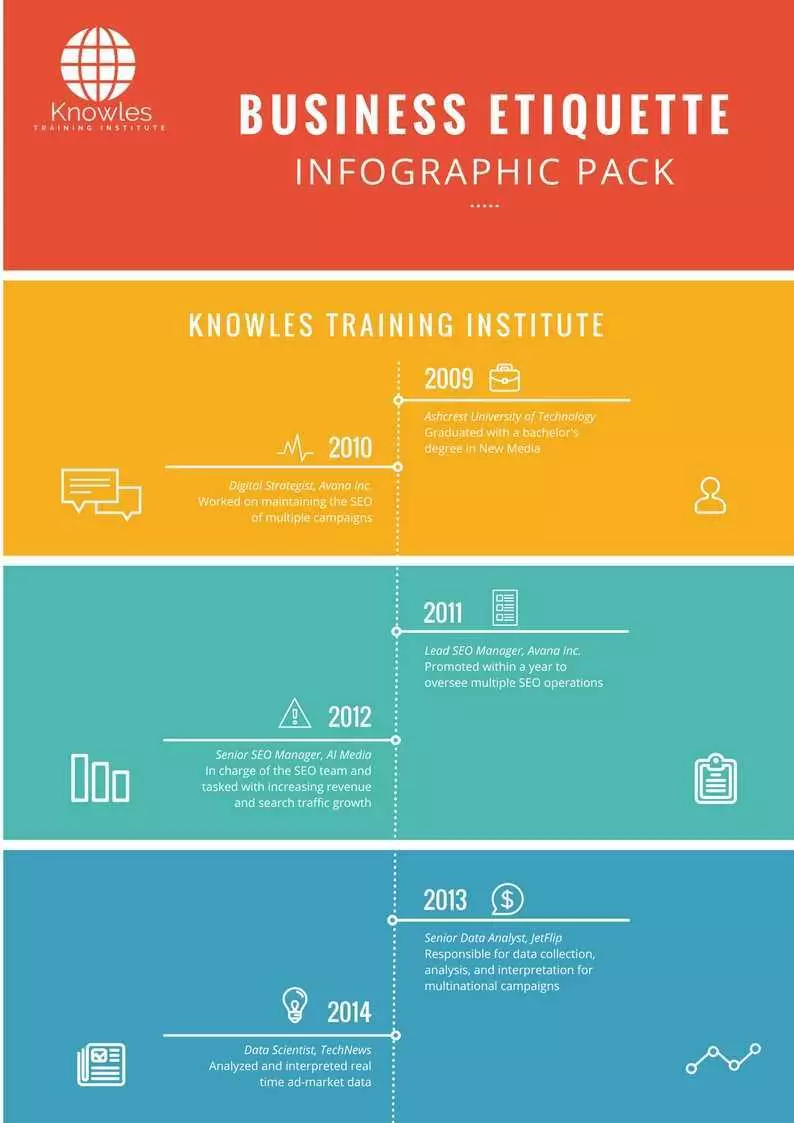
Business Etiquette Certification
Each course participant will receive a certification of training completion
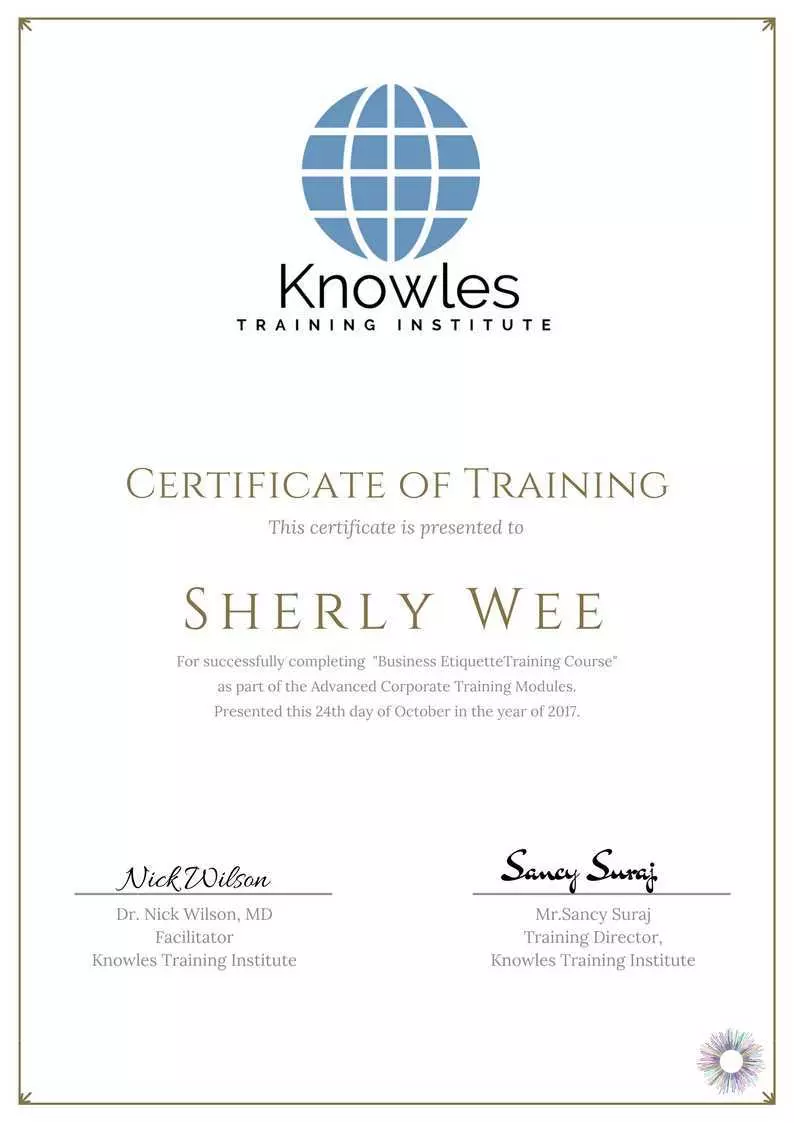
Business Etiquette Course Fees
There are 4 pricing options available for this Business Etiquette training course. Course participants not in Singapore may choose to sign up for our online Business Etiquette training course.
- USD $889.97 For a 60-minute Lunch Talk Session.
USD $389.97 For a Half Day Course Per Participant.
USD $589.97 For a 1 Day Course Per Participant.
USD $789.97 For a 2 Day Course Per Participant.
Discounts available for more than 2 participants.
Upcoming Business Etiquette Training Course Schedule
Contact us for the latest Business Etiquette course schedules:
Phone: +65 6714 6663
Email: contact@knowlesti.sg
Message:
Download Business Etiquette Course Brochure

Request for this Business Etiquette course brochure. Fill up the short information below and we will send it to you right away!
Post-Training Support: A vast majority of training does not have any effect beyond 120 days. But to work, training has to have a strong pre- and post-training component. Post-training reinforcement consequently helps individuals to recall the understanding and ask questions.
Blended Learning: Learning does not occur in the classroom. Virtually everybody prefers distinct ways of learning. Successful learning should have a multi-channel, multi-modal strategy.
We Understand The Industry: Similarly, we’ve got a profound comprehension of the business, business design, challenges, strategy and the that our participants are in and have designed the courseware to cater to their professional needs.
Course Content: Knowles Training Institute’s material is relevant, of high quality and provide specific learning outputs. As a result, Participants will leave the training course feeling as they have gained a strong understanding and will also be in a position to execute what they have learned sensibly.
Course Development — The workshop modules follow a systematic and logical arrangement. Therefore, this structure helps to ensure that the course material allows the facilitators to deliver the course in a logical arrangement. Consider the subjects as building bricks into learning, our facilitators slowly build towards a comprehensive picture of this entire topic.


Business Etiquette Course Enquiries

Fill up the form and we will get back to you in less than 1 working day.
Alternatively, give us a call to have one of our training consultants contact you. Our corporate training courses can be contextualized to meet your organization’s training needs. Leverage on our large pool of professional trainers and consultants for your organization’s training needs.
Office Address: 60 Paya Lebar Rd, #07-54 Paya Lebar Square, Singapore 409051
Office Phone: +65 6714 6663
Email: contact@knowlesti.sg
We Guarantee 100% Privacy. We Respect Your Privacy. Your Information Will Never Be Shared.


